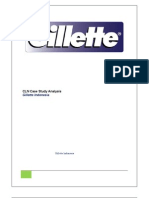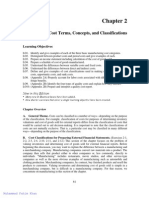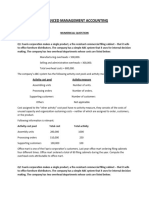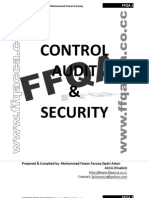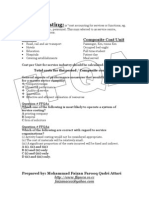Throughput Accounting
Throughput Accounting
Uploaded by
Mohammad Faizan Farooq Qadri AttariOriginal Description:
Copyright
Available Formats
Share this document
Did you find this document useful?
Is this content inappropriate?
Report this DocumentCopyright:
Available Formats
Throughput Accounting
Throughput Accounting
Uploaded by
Mohammad Faizan Farooq Qadri AttariCopyright:
Available Formats
THROUGHPUT ACCOUNTING
‘A technique where the primary goal is to maximize throughput while simultaneously maintaining or
decreasing inventory and operating costs.’ CIMA Official Terminology 2005
CONCEPT
In the short run, all costs in the factory are likely to be fixed with the exception of materials costs
In a JIT environment then we should be attempting to eliminate inventories. Use of a limited resource in
production of inventories should be avoided and therefore any work-in-progress should be valued at
only the material cost
STEPS OF THROUGHPUT ACCOUNTING
Identify the system constraint
Is the constraint internal, for example, in production, engineering or planning? Is it external, for
example, in the market? Is it a resource or is it a policy?
Decide how to maximize the output from the constraint
Prepare to subordinate all other activities to this decision. Non-constraints must be subordinate to
the needs of the constraint. Once the resource constraint has been identified, consideration can be
given to deploying the appropriate level of resources. As a consequence, the constraint's capacity is increased.
Identified policy constraints can be more easily eliminated
Once a constraint has been rectified, go back to step one to identify the next most serious constraint
and repeat.
TOC and TA detractors' summary of criticisms Specific
Criticisms have been levelled at TOC and TA and are discussed below:
They are short-term decision tools.
They may only be valid concepts if applied to the totality of the supply chain including
management, production, resources and support.
Dependent on circumstances, operating expenses under TOC/TA are regarded as fixed,
which is simplistic in the view of detractors. Therefore TOC and TA are basically the same
thing as variable costing.
FORMALS
The TA ratio should be greater than 1 if a product is to be viable. Priority should be given to those
products which generate the highest TA ratios.
Compiled by: Mohammad Faizan Farooq
Contact: farooqtola@gmail.com
EXAMPLE 01
EXAMPLE 02
Compiled by: Mohammad Faizan Farooq
Contact: farooqtola@gmail.com
Question 01
When machine time is a binding constraint on production output, which one of the following will
have no effect on the throughput accounting ratio for a product that the machine is used to
manufacture?
A Obtaining a lower purchase price for materials for the product
B Reducing factory costs
C Reducing the machine time per unit to make the product.
D Increasing the selling price of the product
Question 02
Product X is made in a production process where machine time is a bottleneck resource.
One unit of Product X requires 0.1 machine hours.
The costs and selling price of Product X are as follows:
$ $ $
Materials 6 Labour (0.25 hours) 3 Other factory costs 5
Sales price 15
In a system of throughput accounting, what is the return per factory hour?
A $90. B $60 C $10 D $4
Question 03
MN manufactures automated industrial trolleys, known as TRLs.
Each TRL sells for $2,000 and the material cost per unit is $800.
There is no limit to sales demand.
Costs next year will be $264,000 for factory labour, $834,000 for production overheads, and
$265,000 for marketing and administrative costs.
The trolleys are made on two different machines.
Machine X can produce the parts for 40 TRLs each week but it is old and unreliable and it breaks
down from time to time. It is estimated that on average 15% of production time on this machine is
lost. Machine Z, which is reasonably reliable, can process and assemble 30 TRLs per week.
The company has recently introduced a just-in-time (JIT) system and it is company policy to hold
little work-in-progress and no finished goods inventory from week to week.
The company operates a 40-hour week, 48 weeks a year.
Required The throughput accounting ratio for the key resource for an average hour next year will be:
A 1.078 B 1.268 C 1.338 D 1.574.
Question 04
The following statements have been made about throughput accounting.
(1) When throughput accounting (TA) is used, the aim should be to have sufficient inventories to
overcome bottlenecks in production.
(2) Throughput accounting is based on the assumption that in the short run, most factory costs,
other than materials, are fixed.
Which of the above statements is/are true?
A 1 only B 2 only. C Neither 1 nor 2 D Both 1
and 2
Compiled by: Mohammad Faizan Farooq
Contact: farooqtola@gmail.com
Question 05
Product Z is made in a production process where machine time is a bottleneck resource.
One unit of Product X requires 0.3 machine hours. The costs and selling price of Product X are as
follows:
$ $ $
Materials 8 Labour (0.4 hours) 4 Other factory costs 2
Sales price 18
In a system of throughput accounting, what is the throughput accounting ratio for Product Z?
A 1.29 B 1.67. C 3.00 D 4.00
Question 06
In the theory of constraints and throughput accounting, which of the following methods may be
used to elevate the performance of a binding constraint?
(1) Acquire more of the resource that is the binding constraint.
(2) Improve the efficiency of usage of the resource that is the binding constraint.
A 1 only B 2 only C 1 and 2. D Neither 1 nor 2
Question 07
8 The following statements have been made about throughput accounting and the theory of
constraints. (1) When an existing bottleneck is overcome (‘elevated’), a new bottleneck will appear.
(2) In any commercial organization, it should be expected that the throughput accounting ratio for
any product will exceed 1.
Which of the above statements is/are true?
A 1 only B 2 only C Neither 1 nor 2 D Both 1 and 2.
Question 08
A manufacturing company uses throughput accounting. It has identified Labour Grade A as its
bottleneck resource.
Which one of the following measures might enable the company to improve its total throughput?
(1) Reduce the selling prices of some products in order to increase sales demand.
(2) Improve the efficiency of machine usage by cutting down wastage.
(3) Pay Grade A labour overtime at a premium of $4 per hour in order to work additional hours.
A Measure 1 B Measure 2 C Measure 3.
D None of the measures will increase throughput
Question 09
One of the products manufactured by a company is Product X, which sells for $40 per unit and has a
material cost of $10 per unit and a direct labour cost of $7 per unit.
The total direct labour budget for the year is 50,000 hours of labour time at a cost of $12 per hour.
Factory overheads are $2,920,000 per year. The company is considering the introduction of a system
of throughput accounting. It has identified that machine time as the bottleneck in production.
Product X needs 0.01 hours of machine time per unit produced.
The maximum capacity for machine time is 4,000 hours per year.
What is the throughput accounting ratio for Product X?
A $3.41. B $2.80 C $2.10 D $1.90
Compiled by: Mohammad Faizan Farooq
Contact: farooqtola@gmail.com
Bottleneck Resource
In practice, it is likely that a product will have to be worked on by several machines - one after the
other. The rate of production will be restricted by the slowest of the machines, and this machine is
known as the bottleneck resource. The calculations that we have been through in the earlier
examples will be performed using the hours per unit in this bottleneck resource
Question 10
Budget information relating to a company that manufactures four products is as follows.
Only 750 machine hours are available during the period.
Applying the principles of throughput accounting, how many units of Product B should be made if
the company produces output to maximize throughput and profit?
A 0 units B 250. units C 375 units D 500 units
Compiled by: Mohammad Faizan Farooq
Contact: farooqtola@gmail.com
You might also like
- Chapter 24 - Professional Money Management, Alternative Assets, and Industry EthicsDocument48 pagesChapter 24 - Professional Money Management, Alternative Assets, and Industry Ethicsrrrr110000No ratings yet
- Redesigning Cost Systems: Is Standard Costing Obsolete?Document10 pagesRedesigning Cost Systems: Is Standard Costing Obsolete?SillyBee1205No ratings yet
- The Afn FormulaDocument1 pageThe Afn Formulasplendidhcc100% (2)
- Gillette IndonesiaDocument20 pagesGillette IndonesiaJehad Negem100% (4)
- Basson, BK Appeal Brief New (2)Document22 pagesBasson, BK Appeal Brief New (2)Ron Houchins100% (1)
- Throughput Accounting F5 NotesDocument7 pagesThroughput Accounting F5 NotesSiddiqua KashifNo ratings yet
- Capacity Planning, Facility Location & LayoutDocument56 pagesCapacity Planning, Facility Location & LayoutFekadu100% (1)
- Life Cycle Costing and Environmental AccountingDocument32 pagesLife Cycle Costing and Environmental AccountingImran UmarNo ratings yet
- Summary of Throughput AccountingDocument2 pagesSummary of Throughput AccountingEduardo GreatNo ratings yet
- Target - Costing F5 NotesDocument4 pagesTarget - Costing F5 NotesSiddiqua KashifNo ratings yet
- International BusinessDocument59 pagesInternational BusinessRizwan ZisanNo ratings yet
- End-Of-Chapter Answers Chapter 8 PDFDocument16 pagesEnd-Of-Chapter Answers Chapter 8 PDFSiphoNo ratings yet
- 02 Costs Terms Concepts and ClassificationsDocument66 pages02 Costs Terms Concepts and ClassificationsCherseaLizetteRoyPicaNo ratings yet
- Activity Based CostingDocument2 pagesActivity Based CostingVivek KheparNo ratings yet
- 10 Variance Analysis Concepts PDFDocument5 pages10 Variance Analysis Concepts PDFbarakkat72No ratings yet
- Hurwicz Criterion in Decision TheroryDocument11 pagesHurwicz Criterion in Decision TherorysubinNo ratings yet
- Target Costing Presentation FinalDocument57 pagesTarget Costing Presentation FinalMr Dampha100% (1)
- Capital Budgeting: Required ReadingsDocument39 pagesCapital Budgeting: Required ReadingsAbraham Gebregiorgis BerheNo ratings yet
- Practice Questions For Ias 16Document6 pagesPractice Questions For Ias 16Uman Imran,56No ratings yet
- Managerial (Cost) Accounting Chapter's LecutersDocument710 pagesManagerial (Cost) Accounting Chapter's LecutersMuhammad Fahim Khan100% (1)
- MULTIPLE CHOICE. Choose The One Alternative That Best Completes The Statement or Answers The QuestionDocument9 pagesMULTIPLE CHOICE. Choose The One Alternative That Best Completes The Statement or Answers The QuestionCHAU Nguyen Ngoc BaoNo ratings yet
- Marginal CostingDocument10 pagesMarginal CostingJoydip DasguptaNo ratings yet
- Division Performance MeasurementDocument31 pagesDivision Performance MeasurementKetan DedhaNo ratings yet
- 05 AC212 Lecture 5-Marginal Costing and Absorption Costing PDFDocument22 pages05 AC212 Lecture 5-Marginal Costing and Absorption Costing PDFsengpisalNo ratings yet
- Ama Long QuestionDocument30 pagesAma Long Questionmalikahsanrazaawan7No ratings yet
- Chapters 11 and 12 EditedDocument13 pagesChapters 11 and 12 Editedomar_geryes0% (1)
- Break-Even Analysis/Cvp AnalysisDocument41 pagesBreak-Even Analysis/Cvp AnalysisMehwish ziadNo ratings yet
- IAS 11 Construction ContractsDocument5 pagesIAS 11 Construction ContractsMohammad Ehsan IrfanNo ratings yet
- Marginal & Absorption CostingDocument26 pagesMarginal & Absorption CostingPrachi VaishNo ratings yet
- Relevant Costing or Incremental AnalysisDocument48 pagesRelevant Costing or Incremental Analysis06162kNo ratings yet
- Throughput AccountingDocument12 pagesThroughput AccountingSaqib Akhtar100% (3)
- Chapter 24-Professional Money Management, Alternative Assets, and Industry EthicsDocument10 pagesChapter 24-Professional Money Management, Alternative Assets, and Industry Ethicsrrrr110000No ratings yet
- Handout - Decision TreeDocument9 pagesHandout - Decision TreeSakshi NarayanNo ratings yet
- Decision MakingDocument12 pagesDecision MakingHanisa HanzNo ratings yet
- Stevenson 13e Chapter 1Document30 pagesStevenson 13e Chapter 1zkNo ratings yet
- Chapter 10Document90 pagesChapter 10Aftarur Rahaman AnikNo ratings yet
- CHP 12 - Strategy, Balanced Scorecard, and Strategic Profitability (With Answers)Document54 pagesCHP 12 - Strategy, Balanced Scorecard, and Strategic Profitability (With Answers)kenchong7150% (1)
- Module 1 PDFDocument13 pagesModule 1 PDFWaridi GroupNo ratings yet
- 19733ipcc CA Vol2 Cp4Document70 pages19733ipcc CA Vol2 Cp4m kumar100% (1)
- CHAPTER 1 Intermediate Acctg 1Document58 pagesCHAPTER 1 Intermediate Acctg 1Tessang OnongenNo ratings yet
- B5: Problem Solving: P.O.Box 10378 Mwanza-TanzaniaDocument9 pagesB5: Problem Solving: P.O.Box 10378 Mwanza-TanzaniaSHWAIBU SELLANo ratings yet
- Managerial Accounting: Tools For Business Decision-MakingDocument56 pagesManagerial Accounting: Tools For Business Decision-MakingdavidNo ratings yet
- AFA2e Chapter03 PPTDocument50 pagesAFA2e Chapter03 PPTIzzy BNo ratings yet
- Chapter 4 - Budgetary ControlDocument13 pagesChapter 4 - Budgetary ControlBinish JavedNo ratings yet
- Ch4 LimitFactor QDocument6 pagesCh4 LimitFactor QFatikoNo ratings yet
- Cost Accounting 1 (Acct 403)Document43 pagesCost Accounting 1 (Acct 403)OFORINo ratings yet
- TB Incremental AnalysisDocument41 pagesTB Incremental AnalysisBusiness MatterNo ratings yet
- Target CostingDocument9 pagesTarget CostingRahul PandeyNo ratings yet
- All Intermediate ChapterDocument278 pagesAll Intermediate ChapterNigus AyeleNo ratings yet
- Responsibility AccountingDocument25 pagesResponsibility AccountingAndrew MirandaNo ratings yet
- Chap16-Standard Costing FOHDocument93 pagesChap16-Standard Costing FOHGeo Rublico ManilaNo ratings yet
- Capital Structure TheoryDocument27 pagesCapital Structure Theoryaritraray100% (2)
- Job Costing CADocument13 pagesJob Costing CAmiranti dNo ratings yet
- DocDocument34 pagesDocaldric taclanNo ratings yet
- Intermediate AccountingDocument60 pagesIntermediate AccountingResky Andika YuswantoNo ratings yet
- Module 12 - Relevant Costing and Short-Term Decision MakingDocument8 pagesModule 12 - Relevant Costing and Short-Term Decision MakingAndrea ValdezNo ratings yet
- Cost Ii CH 2Document23 pagesCost Ii CH 2TESFAY GEBRECHERKOSNo ratings yet
- Impairment of AssetsDocument19 pagesImpairment of AssetsTareq SojolNo ratings yet
- CH 22 Exercises ProblemsDocument3 pagesCH 22 Exercises ProblemsAhmed El Khateeb100% (1)
- GNBCY Chap07 Activity Based Costing With Cover PageDocument78 pagesGNBCY Chap07 Activity Based Costing With Cover PageGernette Condez TanNo ratings yet
- Financial Planning and BudgetingDocument3 pagesFinancial Planning and BudgetingMuhammad RamzanNo ratings yet
- Corporate Financial Analysis with Microsoft ExcelFrom EverandCorporate Financial Analysis with Microsoft ExcelRating: 5 out of 5 stars5/5 (1)
- Cost ClassificationDocument19 pagesCost ClassificationMohammad Faizan Farooq Qadri Attari100% (1)
- Limiting Factors & Linear ProgrammingDocument8 pagesLimiting Factors & Linear ProgrammingMohammad Faizan Farooq Qadri AttariNo ratings yet
- Cost BehaviourDocument34 pagesCost BehaviourMohammad Faizan Farooq Qadri AttariNo ratings yet
- Bank ReconciliationDocument7 pagesBank ReconciliationMohammad Faizan Farooq Qadri AttariNo ratings yet
- Profiles of The Faculty Members FNRDocument1 pageProfiles of The Faculty Members FNRFaizan Farooq Qadri AttariNo ratings yet
- Kaplan Exam Tips - FfqaDocument7 pagesKaplan Exam Tips - FfqaMohammad Faizan Farooq Qadri AttariNo ratings yet
- Motivation: Prepared By: Mohammad Faizan Farooq Qadri Attari ACCA (Finalist) ContactDocument9 pagesMotivation: Prepared By: Mohammad Faizan Farooq Qadri Attari ACCA (Finalist) ContactMohammad Faizan Farooq Qadri AttariNo ratings yet
- IAS 16 by FFQADocument9 pagesIAS 16 by FFQAMohammad Faizan Farooq Qadri Attari0% (1)
- Investment Appraisal Theory Practical: Prepared By: Mohammad Faizan Farooq Qadri Attari ACCA (Finalist) ContactDocument19 pagesInvestment Appraisal Theory Practical: Prepared By: Mohammad Faizan Farooq Qadri Attari ACCA (Finalist) ContactMohammad Faizan Farooq Qadri Attari100% (3)
- Ias 10 - Events After Reporting PeriodDocument3 pagesIas 10 - Events After Reporting PeriodMohammad Faizan Farooq Qadri AttariNo ratings yet
- Control, Audit and Security - ACCA F1Document13 pagesControl, Audit and Security - ACCA F1Mohammad Faizan Farooq Qadri AttariNo ratings yet
- Control, Audit and Security - ACCA F1Document13 pagesControl, Audit and Security - ACCA F1Mohammad Faizan Farooq Qadri AttariNo ratings yet
- Ias 23 - Borrowing CostDocument3 pagesIas 23 - Borrowing CostMohammad Faizan Farooq Qadri AttariNo ratings yet
- Job Costing - WWW - Ffqacca.co - CCDocument4 pagesJob Costing - WWW - Ffqacca.co - CCMohammad Faizan Farooq Qadri AttariNo ratings yet
- Service CostingDocument2 pagesService CostingMohammad Faizan Farooq Qadri Attari100% (1)
- Ias 10 - Events After Reporting PeriodDocument1 pageIas 10 - Events After Reporting PeriodMohammad Faizan Farooq Qadri AttariNo ratings yet
- Factoring and IngDocument20 pagesFactoring and Ingapi-3865133No ratings yet
- Asian 2017Document321 pagesAsian 2017Jupe JonesNo ratings yet
- Delta One Tracker Certificate On Swiss EquityDocument1 pageDelta One Tracker Certificate On Swiss Equityapi-25889552No ratings yet
- Organizational Change v. CIRDocument16 pagesOrganizational Change v. CIRaudreydql5No ratings yet
- VortexDocument13 pagesVortexPorav MalhotraNo ratings yet
- CE 474 - Construction Project Scheduling: Fall Semester 2016Document9 pagesCE 474 - Construction Project Scheduling: Fall Semester 2016Zain ShujaNo ratings yet
- Clearance of Goods For WarehousingDocument46 pagesClearance of Goods For WarehousingCloud victorNo ratings yet
- BQS FormDocument5 pagesBQS FormMrPepper MintNo ratings yet
- CC Unit 7, Complaints and Adjustments (Contd)Document23 pagesCC Unit 7, Complaints and Adjustments (Contd)Trang ĐàoNo ratings yet
- Abdul Hafiz Ariffin CV-Tutorv2Document2 pagesAbdul Hafiz Ariffin CV-Tutorv2Abdul HafizNo ratings yet
- Third Party Logistics (3Pl) and Fourth Party Logistics (4Pl)Document21 pagesThird Party Logistics (3Pl) and Fourth Party Logistics (4Pl)Seema Haloi100% (1)
- Trinidad and Tobago Local Content Policy FrameworkDocument7 pagesTrinidad and Tobago Local Content Policy Frameworktsar_philip2010100% (2)
- Name Netid Group Number: Website Link: Tutorial Details Time Spent On AssignmentDocument10 pagesName Netid Group Number: Website Link: Tutorial Details Time Spent On AssignmentcstoneeeeNo ratings yet
- Guide Notes On Donor'S Tax Donor'S Tax: Tax 2 Syllabus Associate Dean Lily K. Gruba S/Y 2017-201Document10 pagesGuide Notes On Donor'S Tax Donor'S Tax: Tax 2 Syllabus Associate Dean Lily K. Gruba S/Y 2017-201Jet GarciaNo ratings yet
- NetVaultBackup 11.4 CLIReferenceGuideDocument118 pagesNetVaultBackup 11.4 CLIReferenceGuideGokul VeNo ratings yet
- Post Office Rates Brochure (1 April 2013-31 March 2014) of South AfricaDocument40 pagesPost Office Rates Brochure (1 April 2013-31 March 2014) of South AfricaskattejagNo ratings yet
- Abb Sras 1-07-72dpiDocument100 pagesAbb Sras 1-07-72dpiahmetgumus1900No ratings yet
- Iso Audit ChecklistDocument20 pagesIso Audit ChecklistAnonymous 4e7GNjzGW100% (1)
- Career MGMTDocument109 pagesCareer MGMTshan4600No ratings yet
- A Narrative Report of On-The-Job Training at El Rancho Hotel Resort and Casino Biñan City LagunaDocument39 pagesA Narrative Report of On-The-Job Training at El Rancho Hotel Resort and Casino Biñan City LagunaRabren Anzano Escueta INo ratings yet
- GU - SAP S4 HANA - How Does The GR - IR Process Work in S - 4HANA and FioriDocument40 pagesGU - SAP S4 HANA - How Does The GR - IR Process Work in S - 4HANA and FioriMickael QUESNOTNo ratings yet
- Tax Invoice: Taxes RateDocument1 pageTax Invoice: Taxes RateHence Proved ElectricallyNo ratings yet
- Tata Indica v2 Xeta CarDocument89 pagesTata Indica v2 Xeta Carsantoshk165No ratings yet
- Hill 2e Closing Case Ch04Document4 pagesHill 2e Closing Case Ch04Afrin Azad MithilaNo ratings yet
- Early Stage Pitch DeckDocument22 pagesEarly Stage Pitch DecksinanzabunogluNo ratings yet
- AP2017Document6 pagesAP2017Sanjeev ThadaniNo ratings yet
- NIT DatesDocument2 pagesNIT DatesBaranitharan ArumugamNo ratings yet
- Krispy Kreme Case Study - ReymarrHijaraDocument10 pagesKrispy Kreme Case Study - ReymarrHijaraReymarr HijaraNo ratings yet



